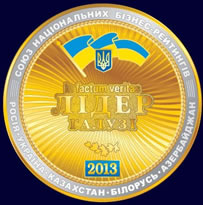Sanatorium Khmelnik VKS
Centrally located in Khmelnik resort, the health resort / sanatorium Khmelnik is set in an old-aged arboretum park, a monument of landscape art. The spacious park occupies a territory of 65 Hectares. There are 122 species of shrubs and trees in the park and a man-made lake. Mineral well with radon-sodium-carbonate water is used for treatments.
A genuine pearl of Podoliye, the health resort Khmelnik is featured far beyond Ukrainian borders. Located on the bank of the Yuznyi Bug, the cozy resort is well-known for its radon mineral water. Radon baths improve lipidic and water-salt metabolism; exterminate salts, water and urinary acids; have positive influence on immunological system and lipidic enzymes, improves blood coagulation. Radon is used for treatment of thyroid gland, ovaries, metabolism, carbohydrate and mineral metabolism. It lessens content of glucose in blood, balances red and white blood composition, and helps against neuroses and neurotic conditions.
Services
Cafes, pump room of mineral water Zbruchanskaya, beauty parlor, the arboretum park which is a monument of landscape architecture is located in the resort, excursions, car parking.
Sport and Entertainment
Therapeutic sauna with a swimming pool, billiards, tennis courts, volleyball and badminton grounds, table tennis room, fitness room and gymnasium with weight training machines, library, video salon.
Medical services
The main treatment methods used in the sanatorium “Khmelnik VKS”
I. Hydrotherapy:
– Mineral radon baths;
– Sodium chloride baths;
– Coniferous baths;
– Underwater shower-massage in radon and fresh water;
– Whirlpool baths;
– Hydro-galvanic 4-chamber baths;
– Hydro-massage of the gums with radon water;
– Gynecological irrigation with radon water .
II. Thermotherapy:
– Paraffin- mineral-wax therapy.
III. Apparatus physiotherapy:
– Galvanization and electrophoresis with medical substances and dc;
– Electric sleeping;
– Diadynamic therapy (DDT);
– Amplipulse therapy (CMT);
– Electric muscles stimulation;
– D’arsonvalization;
– Ultratontherapy;
– Inductometry;
– UHF-therapy;
– Millimetric wave therapy (IMT);
– Magnetic therapy;
– Ultrasound therapy;
– Ultrasound therapy in radon water;
– Light therapy (local and general ultraviolet radiation);
– Laser therapy (therapy with laser scanning beam, helium – neon laser, infrared radiation), intravenous laser therapy;
– Aerosol therapy;
– Aeroionotherapy;
– Combined methods of physiotherapy: magnet – laser therapy.
IV. Barotherapy:
– Hyperbaric oxygenation.
V. Traction of the spinal cord (cervical spine traction, traction of the lumbar spine – an underwater vertical traction of the spinal cord in radon water).
VI. Drinking of mineral water Zbruchanska.
VII. Climatic (aerotherapy – air baths).
VIII. Psychotherapy.
IX. Acupuncture treatment, Su-Jok therapy.
X. Therapeutic exercise, including and hydrokinezoterapiya in radon water.
XI. Massage, relaxation massage.
XII. Rational healing dietic meals.
Additional treatments (at extra cost): aerosol, oxygen-baro therapy, psychotherapy, acupuncture, hand classic therapeutic massage, relaxing massage, vibrating massage, laser therapy of vessels, speleotherapy, herbal medicine, therapeutic, surgical treatment and prosthetics dentistry, thermotherapy -paraffin and mineral wax applications. Treatment of concomitant diseases of digestive organs is carried out wit the use of mineral waters Zbruchanskaya and Satanovskaya (analogous to mineral water Naftusya).
Accommodation
Sanatorium offers simultaneous treatment and accommodation for 600 visitors. There are 4 dormitory building for accommodation.
Building No 3 (renovated)
- Single Junior Suite, 1-roomed
Room amenities: a bed, TV set, refrigerator, new furniture, bathroom unit (shower, toilet, washbasin, new sanitary equipment); there are rooms with and without a balcony. - Double Apartments, 2-roomed
Room amenities: two beds, TV set, refrigerator, new furniture, dinner set, bathroom unit (bath, toilet, washbasin, new sanitary equipment); - Double Suite, 2-roomed
Room amenities: two beds, TV set, refrigerator, new furniture, dinner set, bathroom unit (bath, toilet, washbasin, new sanitary equipment); - Standard Double Room of 1st category, 1-roomed
Room amenities: two beds, TV set, bathroom unit (shower, toilet, washbasin, new sanitary equipment);
Treatment
The sanatorium is specialized in treatment of: endocrine diseases (diabetes, obesity II - III stage.) Nervous diseases (vascular diseases, peripheral nervous system), cardiovascular diseases (cardiopsychoneurosis, coronary heart disease, hypertension, rheumatism, thrombolytic , varicose diseases), skin and subcutaneous tissue diseases (eczema, neurodermatitis, psoriasis, psoriatic polyarthritis, scleroderma); musculoskeletal and connective tissue diseases, (rheumatoid (infectious, non-specific) polyarthritis, ankylosing spondylitis, metabolic-distractive polyarthritis ); gynecological diseases (chronic inflammation of internal genital organs, fibroids (up to 10 weeks), endometriosis, mastopathy, menopausal syndrome, menstrual disorders, cervical erosion, sterility I-II stage.
97% of holidaymakers have significant health improvements after the treatment in the sanatorium and back to their normal life.
Indications for treatment in the sanatorium "Khmelnik VKS"
Locomotive diseases and injuries (joints, muscles, tendons, bones, etc.):
1. Osteochondrosis of the vertebral column.
2. Deforming spondylosis without severe disorders of the spine mobility.
3. Ankylosing spondylitis (Bechterev's disease), no more than II stage, without systemic manifestations.
4. Chronic infectious spondylitis (non-tuberculosis).
5. Traumatic spondylopathy.
6. Children’s scoliosis.
7. Rheumatoid arthritis no more than II stage, without systemic manifestations, dysfunction of the joints should not more than II stage.
8. Degenerative deformative osteoarthrosis, which has developed as a result of metabolic and endocrine dysfunctions.
9. Polyarthritis of certain infectious etiology (psoriatic, gonorrheal) in remission or when the activity is no more than II stage.
10. Microcrystalline arthritis (gout, chondrocalcinosis).
11. Adult’s aseptic necrosis of the femoral head (idiopathic, posttraumatic).
12. Arthropathy of non-rheumatic diseases (allergic, metabolic, endocrine, etc.).
13. Focal and systemic scleroderma with a chronic course, when activity is no more than I stage.
14. Injuries of joint, extremities and spinal cord with contractures caused by immobilization and neurotrophic disorders.
15. Fractures with delayed consolidation or a painful callus.
16. Infective or traumatic osteitis and periostitis, periostitis caused by gunshot wounds.
17. Extra-articular soft tissue diseases (myositis, bursitis, abscess, periarthritis, aponeurositis).
Cardiovascular system diseases
1. Rheumatism (protracted and latent, the minimum degree of process activity), not earlier than
6 months after the acute endo myocarditis in an inactive process and circulatory failure
absorption is not higher than stage I.
2. Hypertensive heart disease not higher than stage II without frequent crises and expressed vascular sclerosis of the heart, kidneys, brain, if circulatory failure is less than the stage I, hyperkinetic variant of circulation.
3. Essential hypertension (arterial hypertension).
4. Chronic ischemic heart disease (CHD):
a) rare mild fits of stenocardia after considerable physical exercising, without obvious changes of ECG, if circulatory deficiency is not higher than stage I;
b) cardiosclerosis, atherosclerotic with occasional mild stenocardia or without it, without
cardiac arrhythmias if circulatory deficiency is not higher than stage I;
c) cardiosclerosis after myocardial infarction after 1 year of attack, with no signs of stenocardia or with a few mild attacks, with the restoration, without
arterial hypertension, without concomitant prognostic arrhythmias and if circulatory deficiency is not higher than stage I;. On earlier stages (after 1,5-2 months after
the heart attack), chamber baths are prescribed.
5. Post-myocardial cardiosclerosis (non-rheumatic etiology), with no signs of inflammation, circulatory failure, not higher than stage I, and without adverse prognostic violations of heart rhythm.
6. Cardiomyopathy (myocardial) in connection with the overstretch of cardiac muscle, metabolic disorders, endocrine disorders, intoxication in the absence of adverse violations of heart rhythm, if circulatory deficiency is not higher than stage I;
7. Obliterating atherosclerosis of extremities and terminal part of the abdominal aorta at the stages of compensation and subcompensation peripheral circulation, in the absence of ulcers, gangrene, and coronary heart disease higher than functional class II, at 6-8 weeks after surgery on the arteries without ulcers and gangrene in the stage of compensation of the peripheral circulation, in satisfactory general condition.
8. Obliterating thromboangitis, endarteritis of the extremities with blood circulation in stage I and II, only in remission, with no tendency to generalize the process of thrombosis, migratory thrombophlebitis, exacerbations, marked vasomotor disturbances (persistent cyanosis, recent ulceration) and symptoms of the process activity.
9. Residual symptoms after phlebitis, thrombophlebitis of lower extremities after acute and subacute stages:
a) for superficial veins – after 2 months;
b) for deep veins - after 4 months.
10. Venous insufficiency after thrombosis, concomitant with trophic skin changes of tibia (infiltration).
11. Chronic venous insufficiency, which developed as a result of varicose veins, in the stage of compensation and subcompensation.
Diseases of the nervous system. Diseases and aftereffects of peripheral nervous system injure.
1. Radiculitis, radiculoneuritis of different localization disco-genic and infectious-allergic origin in the stage of incomplete remission and chronic clinical course.
2. Polyneuritis, polyradiculitis, plexitis, neuritis of the facial, trigeminal nerve, brachial plexus and separate nerves and extremities (infectious, toxic, after the acute stage, etc.). Neurofibromatosis.
3. Autonomic polyneuropathy, solar plexitis, sympathetic ganglia after the acute stage (2-4 months), professional, angiospastic, segmental-vegetative syndromes.
4. Injures of roots, plexuses, nerve trunks, which do not require surgery and after (2 months) with obvious signs of functional recovery.
Diseases of the female genital organs:
1. Chronic salpingitis and oophoritis after and acute stage (after 2 months), on condition of normal body temperature, without increasing the ESR, without leukocytosis or stab shift.
2. Parametritis, parametritis after acute stage (not earlier than after 4-6 weeks), on condition of normal body temperature, without increasing the ESR, without leukocytosis or stab shift.
3. Pelvic peritoneal adhesions after myocardial inflammatory process in the small pelvis after surgery for an extrauterine pregnancy, or inflammations of fallopian tubes and ovaries (no earlier than 4 weeks).
4. Endometritis, metritis (metroendometrit) in the chronic stage, not earlier than 4 weeks after the acute period, on condition of normal body temperature, without increasing the ESR, without leukocytosis or stab shift.
5. Hypovarianism concomitant with chronic inflammation of genital organs.
6. Complications after uterus surgery, tube and ovaries surgery (post-operative infiltration), not earlier than 1-2 months after the surgery, on condition of normal body temperature, without increasing the ESR, without leukocytosis or stab shift.
7. Infertility resulting from inflammatory diseases of the uterus, fallopian tubes, ovaries, and secondary dysfunctions of the hypophysis - ovary.
8. Inflammatory diseases of female genital organs concomitant with uterine fibromyoma no later than 9 - 10 weeks of pregnancy.
9. Genital endometriosis.
10. Early and complicated climacteric syndrome.
11. Rehabilitation of patients after gynecological operations.
Skin and hypodermic tissue diseases:
1. Psoriasis and psoriasiform diseases:
a) the chronic stage of psoriasis without erythroderma, arthrosis and ankylosis;
b) psoriasis with symptoms of arthralgia, the initial stage of arthrosis, if it is not required confinement to bed;
c) exacerbation of psoriasis.
2. Dermatitis, limited neurodermatitis, various forms of pruritus, various forms of chronic eczema.
3. Litchen (various forms, chronic stage, not widely-spread).
4. Seborrheic eczema.
5. Chronic eczema.
6. Scleroderma, patchy form.
7. Allergic urticaria, other forms of urticaria (mild forms).
Metabolic and endocrine disorders.
1. Diabetes (mild and moderate) in the stage of compensation.
2. Gout, urate diathesis.
3. Hyperthyroidism (mild and moderate).
4. Hypothyroidism in the stage of compensation and subcompensation.
5. I-II stage of obesity , if circulatory deficiency is not higher than stage I;.
Burn diseases
1. Rehabilitation after burns of skin, cardiovascular system, digestive organs.
2. Rehabilitation after post-burn deformities, hypertrophic scars.
3. Psychological correction of burn patients.
Diseases of oral cavity
1. Diseases of the mucous membrane.
2. Gum diseases.
3. Periodontal disease.








